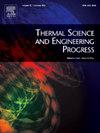Development of a coupled transpiration cooling thermal protection system incorporating self-driven cooling pipes
IF 5.1
3区 工程技术
Q2 ENERGY & FUELS
引用次数: 0
Abstract
To address the growing thermal loads of scramjet engines, a Coupled Transpiration Cooling Thermal Protection System (CTCTPS) integrated with self-driven cooling pipes is proposed. This system combines an S-shaped cooling pipe and a transpiration cooling structure to achieve self-driven and adaptive cooling. It harnesses the heat flux differences on the pipe wall to drive coolant flow inside the pipe for internal structure cooling, while the liquid water in the pipe evaporates or changes phase to provide coolant for transpiration cooling. In this research, different heat flux differences (0–500 W/m2) are used to explore their impacts on fluid flow, phase change, and heat transfer characteristics within the system. The study reveals that the system can remarkably enhance the overall cooling capacity. During the phase change stage, the cooling efficiency of the transpiration cooling structure surface is about 2.7 times that of the local circulation flow stage, and the heat transfer coefficient peaks at 88. By adjusting the heat flux difference, the system can optimize cooling time and coolant consumption. The system eliminates the need for external driving devices by leveraging natural convection induced by heat flux differences and effectively circumvents the instability issues caused by direct phase transitions in porous structures. This work paves a new pathway for comprehensive thermal management system of scramjet engine via the rational design of the CTCTPS with self-driven cooling pipes.
结合自驱动冷却管的耦合蒸腾冷却热保护系统的研制
针对超燃冲压发动机日益增长的热负荷,提出了一种结合自驱动冷却管的耦合蒸腾冷却热保护系统(CTCTPS)。该系统采用s型冷却管和蒸腾冷却结构相结合,实现自驱动、自适应冷却。它利用管壁热流差驱动管内冷却剂流动进行内部结构冷却,同时管内液态水蒸发或相变提供冷却剂进行蒸腾冷却。本研究采用不同的热流密度差(0-500 W/m2)来探讨其对系统内流体流动、相变和换热特性的影响。研究表明,该系统能显著提高整体制冷量。在相变阶段,蒸腾冷却结构表面的冷却效率约为局部循环流动阶段的2.7倍,换热系数峰值为88。通过调节热流密度差,系统可以优化冷却时间和冷却剂消耗。该系统通过利用热流差引起的自然对流,消除了对外部驱动装置的需求,有效地规避了多孔结构中直接相变引起的不稳定性问题。通过合理设计具有自驱动冷却管的CTCTPS,为超燃冲压发动机综合热管理系统开辟了一条新途径。
本文章由计算机程序翻译,如有差异,请以英文原文为准。
求助全文
约1分钟内获得全文
求助全文
来源期刊

Thermal Science and Engineering Progress
Chemical Engineering-Fluid Flow and Transfer Processes
CiteScore
7.20
自引率
10.40%
发文量
327
审稿时长
41 days
期刊介绍:
Thermal Science and Engineering Progress (TSEP) publishes original, high-quality research articles that span activities ranging from fundamental scientific research and discussion of the more controversial thermodynamic theories, to developments in thermal engineering that are in many instances examples of the way scientists and engineers are addressing the challenges facing a growing population – smart cities and global warming – maximising thermodynamic efficiencies and minimising all heat losses. It is intended that these will be of current relevance and interest to industry, academia and other practitioners. It is evident that many specialised journals in thermal and, to some extent, in fluid disciplines tend to focus on topics that can be classified as fundamental in nature, or are ‘applied’ and near-market. Thermal Science and Engineering Progress will bridge the gap between these two areas, allowing authors to make an easy choice, should they or a journal editor feel that their papers are ‘out of scope’ when considering other journals. The range of topics covered by Thermal Science and Engineering Progress addresses the rapid rate of development being made in thermal transfer processes as they affect traditional fields, and important growth in the topical research areas of aerospace, thermal biological and medical systems, electronics and nano-technologies, renewable energy systems, food production (including agriculture), and the need to minimise man-made thermal impacts on climate change. Review articles on appropriate topics for TSEP are encouraged, although until TSEP is fully established, these will be limited in number. Before submitting such articles, please contact one of the Editors, or a member of the Editorial Advisory Board with an outline of your proposal and your expertise in the area of your review.
 求助内容:
求助内容: 应助结果提醒方式:
应助结果提醒方式:


